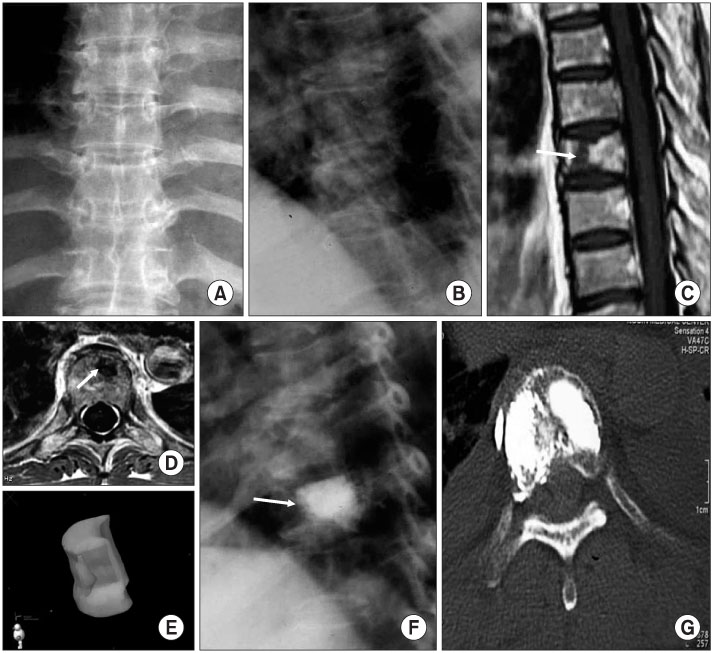J Korean Orthop Assoc.
2011 Apr;46(2):122-129.
The Comparision of the Radiofrequency Ablasion Therapy with Vertebroplasty and Radiotherapy in Metastatic Spine Tumor
- Affiliations
-
- 1Department of Orthopaedic Surgery, Kosin University, Gospel Hospital, Busan, Korea. drjang@hanafos.com
Abstract
- PURPOSE
To evaluation the availability of combined treatment with radiofrequency (RF) ablation with vertebroplasty in patients with metastatic spine tumor.
MATERIALS AND METHODS
Between March 2007 and March 2009, 34 patients with the metastatic spine tumor, RF ablation with vertebroplasty was performed in 17 patients, and radiotherapy in the other 17 patients. Cumulative 1-year patient survival rate were compared with the both groups. Pain relief and quality of life were evaluated with use of the visual analogue scale (VAS) and Roland Moris Questionnaire (RMQ).
RESULTS
Nine of 17 patients with the RF ablasion therapy with vertebroplasty and 8 of 17 patients with radiotherapy were died. Tumor necrosis was observed in 61.2+/-22.4% (range 28-100%) of the tumor volume. In terms of pain relief, VAS score of preoperative, 1 week and 4 weeks following were 7.12, 3.82 and 3.65 in RF ablation with vertebroplasty group, and 7.00, 5.39 and 4.94 in radiotherapy group(p-value <0.001, <0.001). The score of RMQ score was improved from 12.94 to 7.18 in operation group (p-value <0.001), and 14.11 to 10.89 in radiotherapy group(p-value 0.001). But in terms of pain relief (score of VAS) and quality of life (score of RMQ), RF with vertebroplasty group showed significantly better than the radiotheray group (VAS, p for intercation 0.004, RMQ, p for interaction 0.024).
CONCLUSION
RF with vertebroplasty is thought to be a useful method to improve the pain relief and quality of life in patients with metastatic spine tumor.
MeSH Terms
Figure
Reference
-
1. Wise JJ, Fischgrund JS, Herkowitz HN, Montgomery D, Kurz LT. Complication, survival rates, and risk factors of surgery for metastatic disease of the spine. Spine (Phila Pa 1976). 1999. 24:1943–1951.
Article2. Gilbert HA, Kagan AR, Nussbaum H, et al. Evaluation of radiation therapy for bone metastases: pain relief and quality of life. AJR Am J Roentgenol. 1977. 129:1095–1096.
Article3. Poulsen HS, Nielsen OS, Klee M, Rørth M. Palliative irradiation of bone metastases. Cancer Treat Rev. 1989. 16:41–48.
Article4. Hoskin PJ. Palliation of bone metastases. Eur J Cancer. 1991. 27:950–951.
Article5. Janjan NA. Radiation for bone metastases: conventional techniques and the role of systemic radiopharmaceuticals. Cancer. 1997. 80:8 Suppl. 1628–1645.6. Mithal NP, Needham PR, Hoskin PJ. Retreatment with radiotherapy for painful bone metastases. Int J Radiat Oncol Biol Phys. 1994. 29:1011–1014.
Article7. Milker-Zabel S, Zabel A, Thilmann C, Schlegel W, Wannenmacher M, Debus J. Clinical results of retreatment of vertebral bone metastases by stereotactic conformal radiotherapy and intensity-modulated radiotherapy. Int J Radiat Oncol Biol Phys. 2003. 55:162–167.
Article8. Hayashi S, Hoshi H, Iida T. Reirradiation with local-field radiotherapy for painful bone metastases. Radiat Med. 2002. 20:231–236.9. Wright RL. Malignant tumers in the spinal extradural space: results of surgical treatment. Ann Surg. 1963. 157:227–231.10. Chung CY, Lee SY, Baek GH, Lee SH, Ahn JY, Yoon KS. Clinical analysis of metastatic bone tumor. J Korean Orthop Assoc. 1991. 26:1855–1859.
Article11. Tomita K, Kawahara N, Kobayashi T, Yoshida A, Murakami H, Akamaru T. Surgical strategy for spinal metastases. Spine (Phila Pa 1976). 2001. 26:298–306.
Article12. Grönemeyer DH, Schirp S, Gevargez A. Image-guided radiofrequency ablation of spinal tumors: preliminary experience with an expandable array electrode. Cancer J. 2002. 8:33–39.13. Nakatsuka A, Yamakado K, Maeda M, et al. Radiofrequency ablation combined with bone cement injection for the treatment of bone malignancies. J Vasc Interv Radiol. 2004. 15:707–712.
Article14. Dupuy DE, Hong R, Oliver B, Goldberg SN. Radiofrequency ablation of spinal tumors: temperature distribution in the spinal canal. AJR Am J Roentgenol. 2000. 175:1263–1266.15. Froese G, Das RM, Dunscombe PB. The sensitivity of the thoracolumbar spinal cord of the mouse to hyperthermia. Radiat Res. 1991. 125:173–180.
Article
- Full Text Links
- Actions
-
Cited
- CITED
-
- Close
- Share
- Similar articles
-
- Tageted bipolar radiofrequency decompression with vertebroplasty for intractable radicular pain due to spinal metastasis: a case report
- Percutaneous Vertebroplasty in a Patient with an Osteolytic Spinal Metastatic Tumor: A case report
- Treatment of Spinal Osseous Metastasis with Combined Percutaneous Radiofrequency Ablation and Vertebroplasty
- Clinical Efficacy and Safety of Radiofrequency Ablation Therapy with Cement Augmentation for a Metastatic Spine Tumor
- Two Cases of Percutaneous Vertebroplasty for Spinal Metastatic Cancer: A case report


